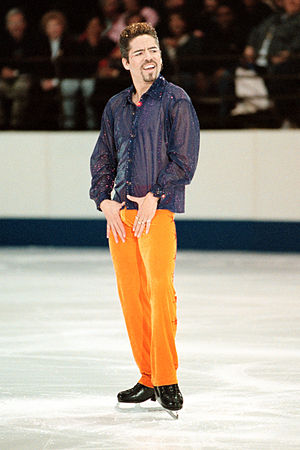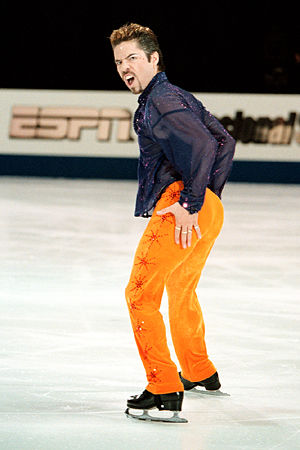

| Graphic by YIKES,Inc. |
This essay is intended for mature readers. (Maturity does not necessarily correlate with age.) Read responsibly. If you feel offended, STOP.

Rudy Galindo's "Studio 54," skated at "Ice Wars" and televised on CBS, November 27, 1999, is the most disliked skating program in U.S. cyberspace this season. With few exceptions, public reaction has been negative, to the extent that according to News on the official Rudy Galindo website, the program has been retired.
What does this program actually look like? Set to a high-energy medley of familiar disco tunes from the "Studio 54" soundtrack, it was intended as a "fun" rather than "technical" number, designed to get the audience to participate by clapping along. Many of the sampled songs have been staples in gay dance clubs.
Galindo wore sparkles in his hair, and adhesive gems around his eyes. His purple mesh shirt was semi-transparent, so that his nipples were visible. His bright orange pants were festooned with eye-catching stars down the outer seam of each leg, and -- the pièce de résistance -- also on his crotch and on each buttock. In all, Galindo's ensemble was appropriate for a dance club, but more provocative than the standard for a family-oriented skating broadcast.
The program started out with a triple toe-triple toe combination, a triple salchow, and a single axel (it should have been a double, but Galindo's efforts to re-train a triple axel appear to have affected his timing on axel jumps). The rest of the program mainly consisted of Galindo dancing on skates, showing that -- unlike some skaters who attempt, less convincingly, to skate club dance-like programs -- he really does go out dancing in real life. At one point, Galindo wiggled his butt for the camera; at another point, he (briefly) framed his crotch with his hands. He paused by the boards to sprinkle glitter on some spectators. His dancing was adept and also undeniably sexual, in an irony-tinged fashion that is typical of gay men on the "flamer" end of the butch-femme spectrum. Of the spectators visible on TV, some appeared to "get it" with enjoyment; others looked distinctly uncomfortable.

Photograph by Debbie Mowry
A small minority of on-line skating fans enjoyed this program, some because of its campy humor, some because they welcomed Galindo's soulful ability to dance in rhythm, some because it brings them joy to see Galindo being himself.
Of the majority who vocally disliked it, there are three major reasons cited, sometimes in combination:
1. A homophobic reaction of disgust.
2. A general dislike of overtly provocative programs.
3. Disappointment in the program's skating content, especially contrasted
with Galindo's abilities.
Although it can be argued that a certain element will always respond homophobically because Galindo is out, and effeminate, this element objected more vehemently to the "Studio 54" program. The one move most often cited was Galindo's butt wiggle, directly into the camera. Granted, CBS was under no obligation to televise this particular angle, so some of the responsibility lies with the producer. That aside, it seems possible that the move may have triggered some homophobes' stereotypical anxieties regarding gay men and anal sex -- the kind of overwhelming anxiety that leads to homophobes thinking that gay men are coming on to them.
The butt-wiggle as a come-on is, in skating, as old as the hills. Scores of female skaters use it without drawing public comment; so do loads of the men, including honestly straight ones such as Kurt Browning and Victor Petrenko, and closeted gay ones such as the pre-palimony suit Brian Orser (his choreographed butt dance in 1993's "Deeply Dippy" always met with screams of female approval).
The difference, this time, is that the butt-wiggler in question is an out, effeminate gay man. Suddenly, there is a din of public disapproval separate from the usual grumblings from those who prefer skating to be less salacious. There is a distinct public message that certain expressions from women and straight men will be permitted, or at least tolerated, but not from out gay men.
Some objectors have been quick to point out that they also dislike overtly provocative programs from skaters who are not gay men. Female skaters whose nipples are visible through transparent tops, such as Alisa Drei and Rosalynn Sumners, have met with majority disapproval; Maya Usova's costume with tassels dangling from her breasts provoked disgust more or less equal to the reaction against Galindo's crotch star.
Probably the closest comparison to the "Studio 54" Rudy Galindo is the heterosexual French skater Philippe Candeloro, who has redefined "exhibition program" since at least 1993 by stripping to the waist at the slightest excuse. While these displays typically draw wild cheers at live events (as do Galindo's show programs), quite a few spectators have expressed disgust at Candeloro. In fact, Candeloro incorporated many provocative moves at the same event ("Ice Wars"), including a direct grip on his genitals (Rainbow Ice did not find this attractive), unambiguous pelvic thrusts, and his customary "audience attack" involving physical flirtation with female spectators (in contrast, Galindo blessing the audience with fairy dust seems refreshingly benign).
So why is there more outcry against exhibitionist programs from Galindo than Candeloro? Homophobia, certainly; also, audiences have had seven long years in which to become numbed to Candeloro's exhibitionism. But the third reason is perhaps the most significant: Galindo is a rare skating talent, the world's best in some areas, a true treasure of male flexibility, spinning ability, and dedication to balletic line and turnout. Some fans perceive the public entertainment element to be less important than the showcasing of these gifts, and are disappointed when they perceive Galindo to be resorting to the cheap gimmick.
These fans will always prefer skating programs that minimize static posing, skating on two feet, and mugging for applause; that maximize thoughtful program layouts and innovative movements from the pure-skating lexicon. As men's skating pushes toward more triples and quads, and away from edge control, well-mastered spins, and thoughtful connecting moves, Galindo is treasured as one of the few remaining active men who can demonstrate the beauty of a well-balanced program. Thus, Galindo carries the burden of fan expectations in a very serious matter that is entirely separate from the responsibility of being the most visibly out gay skater. Of someone like Candeloro, who has sloppy form and whose trademark spin does not even involve skates, there are no such expectations and thus no disappointment.
It is probably just as well that Galindo has retired such an unpopular program. After all, show numbers are intended to please the audience. Nevertheless, Rainbow Ice salutes both Galindo and the program for a number of things.
Most importantly, Galindo was himself. Not all of us in this world are acceptable or salable when we are being ourselves. Some folks unfamiliar with the butch-femme spectrum accuse Galindo of "flaunting it," not realizing that for Galindo, to stop registering as effeminately gay would be to stop breathing. Does anybody doubt that what we see on the ice is exactly the real Rudy Galindo? Does anyone believe that when he goes home, he turns suddenly into Al Gore? What would people have him be?
For Galindo, being true to himself only has saved his life and his skating career. His breakthrough season in 1996 came only after he stopped accepting advice from anyone, and stopped blaming others as well. Sometimes this quality has resulted in naïve errors, such as deductions for programs that did not conform to competition rules. But the thing that must be remembered about Galindo is that for him to try to conform to others' standards would be far more costly. One way or another, it would destroy him.
Galindo's identity as a sexual, out, successful, "Mexican American gay trailer trash" skater is hard won. As anyone familiar with his biography knows, he has been poor and stigmatized most of his life, his dreams cruelly toyed with by fate. Unlike a skater such as Scott Hamilton, Galindo does not live for fan approval. He's lived without it before, and he can again. But he could not live with skating in a way that would feel to him like a denial of his hard-won identity.
Galindo's true self is effeminate and gay; it is also the sum of the battles he has fought with those who object to the existence of effeminate and gay. The dancing style in the "Studio 54" program provoked in part because it was an answer to a provocation: the homophobia that works to deny the sexuality of all queer people. It is possible that the costume would have fallen just on the safe side of the line if not for the star sparkling directly over Galindo's genitals, refusing to permit his sexuality to be ignored.

Photograph by Debbie
Mowry
As a rule, American audiences respond negatively to skating that highlights the genitals; that crosses the American cultural public/private boundary. Earlier this season, there was a huge uproar of disapproval from American fans when the French pair team of Sarah Abitbol and Stéphane Bernadis rotated a cantilever that drew the eye to Abitbol's crotch. More than one alienated observer noted that the diamond-shaped crotch gusset in Abitbol's costume further highlighted this move. It seems safe to say that skaters performing for American audiences would do well to note and respect the mainstream U.S. comfort level here, which seems to apply across the board regardless of the skater's gender or orientation.
Perhaps the most valuable thing about Galindo's "Studio 54" program is one that would not occur to mainstream skating fans. Despite the existence of other out élite skaters, Galindo remains the one that people think of, that provides a point of identification and pride for gay viewers who may otherwise know little about skating. He's the one whose skating clips are shown on highlight reels in gay bars, whose name appears on "men we love" lists in gay magazines. In a sport viewed by many gay men as being in bewildering, unnecessary denial about the significant number of gay participants, Galindo is seen as a refreshingly honest voice.
Then there is the matter of the kind of gay image Galindo projects. His adept, exhibitionistic dancing in "Studio 54" has a hard-won beauty about it that many gay viewers can recognize from their own comings-of-age on gay dance club floors across the U.S. -- an inborn rhythm that has had to be defended against gay-bashing since childhood, a defiant and self-conscious escape into movement that speaks volumes about the struggle of gay men to claim and own their own beauty and human sexual dignity in a society that stigmatizes them as monsters.
"Ice Wars," where Galindo skated "Studio 54," had a number of outrageous performances by men. In addition to Candeloro's het-caricature burlesque, there were: the ultra-Russian "Swan Lake" from ornately costumed Alexei Urmanov, skating both male and female roles (a skater whose St. Petersburg classical mannerisms often read as "gay" to American audiences, although Rainbow Ice is sure that Urmanov is heterosexual); "Play That Funky Music, White Boy" from the heterosexual Kurt Browning, whose butt-wiggling was every bit as adept and salacious as Galindo's; and the equally approval-seeking, retro-geek "White Elephants" from Brian Boitano, who to Rainbow Ice's knowledge has not publicly declared any sexual orientation. By pro skating's standards, it was an unusually rich and successful group of men's programs, and Rainbow Ice is proud that Galindo's portrayal of the club dance persona was represented among them.
Diehard skating fans often say they long to see Galindo challenge himself, create masterpieces in the vein of his idol, the late John Curry. It is worth pointing out that Galindo is hardly the pro skater with the most precipitous or surprising decline in skating quality. Bear with the argument; there is a point other than mean-spiritedness.
The prize for most disappointing pro career must go without dispute to the formerly enchanting Lu Chen of China, who months after winning a second Olympic bronze medal in 1998 was collecting paychecks for performances in which she would underrotate and fall on single axels. Among men, Victor Petrenko, who as an eligible delivered creative spins and thoughtfully paced triples, has a pro career notable for cartoonishly bad programs (if you haven't seen "Red Rooster," count yourself lucky) that bypass his skating skills.
The point of mentioning Chen and Petrenko is this: like Galindo, they were in the eligible game for a long time before they turned pro, and perhaps got more opportunity than most to make their artistic statements while eligible. Both Chen and Petrenko went to three Olympics and won medals at two. Galindo, while he never made an Olympic team, went to Worlds as U.S. pair champion in 1989 -- a full seven years (approximately two skating generations) before qualifying in men's singles. He is 30 years old this year. By skating standards, in a world where 16-year-olds are trying quads before their muscles tear loose from the bone, Galindo hasn't been a young man for a very long time.
His age means he could, if he wanted, give the world the truly visionary mature programs that many crave. It also means, however, that he has a limited time in which to put lucrative touring fees in the bank before promoters stop calling. These two goals can sometimes, in fact, work against each other to some extent. In 1996, Galindo said he planned to tour 3-4 years and then see what to do next. As crass as this may sound, the rumored addition of the crowd-pleasing backflip to his repertoire may extend his salability a bit. The bulk of Galindo's income is earned from fans who enjoy his rousing numbers, not the connoisseurs of Ina Bauers or the perfect running three-turn series.
Galindo's other program from "Ice Wars," to the Stanford University Fleet Street Singers' a cappella cover of "The Rose" (specially recorded for Galindo), did indeed show that Galindo's skating still has new things to offer. At an age when most pro skaters are long past lingering on moves that showcase flexibility, Galindo highlighted two: a sideways flexibility sitspin, and a Charlotte spiral.
To include the Charlotte is a classic "take that!" Galindo gesture, and in a way, a bit of a gender-bender. Spirals (skating on an edge while the free, non-skating leg is held at hip level or higher) are considered "women's moves," although men sometimes do them, because they are required in the ISU short programs for women but not for men. The Charlotte spiral, an old show move in which the skater's upper body dips down while the free leg approaches the vertical, is currently repopularized because Olympic silver medalist Michelle Kwan (a tourmate whom Galindo has admired publicly as "a beautiful person -- beautiful on the inside") has made it a highlight move for the past two seasons. As a result, it has been popping up in women's programs all over recently -- but Galindo has been doing this move for years, and his Charlotte may be faster and better-extended than any of the women's.
It is these glimpses of Galindo's mastery that tantalize, when Galindo skates programs of lesser content and then places poorly in pro competition. It is a fact that his skating is slower and less powerful than some of his competitors', such as Boitano or Browning. If he is to do well (and doing well does matter to him), he must rely on thoughtful choreography and unique, well-performed skating moves as well as jumps and his ability to ignite the crowd. There are performed and never-performed programs from his eligible career that could be adapted for this purpose.
There will always be some for whom Galindo is too much, too far on the effeminate end of the spectrum. Even within the gay community, there is always an element that wishes all the Gay Pride celebrants would march in suits and ties. This will not change. Since it will not, Galindo should not concern himself with it. But what will change is the response of the judges, to pro programs with higher content. In other words: Rudy, as long as you have the jumps, the footwork, the spins and connecting moves, be as outrageous as you want. If you want to be outrageous, you must back it up with the skating.
Four years after his breakthrough as the oldest modern U.S. men's champion, Rudy Galindo is still an A-list pro, still getting more applause than any skater on the Champions on Ice tour except Michelle Kwan. Through his admitted struggles with addiction and depression, he has never cheated the audience. Even when displeased with his jumps, Galindo never lets up on his pride of performance -- he always gives the people a show. In the early 1990s, when he skated in obscurity, there was no way to know that Galindo would become the veteran entertainer and gay hero that he is today. He is a cultural treasure, and Rainbow Ice salutes his work.